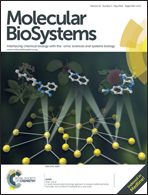Transcriptional profiling and co-expression network analysis identifies potential biomarkers to differentiate chronic hepatitis B and the caused cirrhosis†
Abstract
Liver cirrhosis is one of the most common non-neoplastic causes of mortality worldwide. Chronic hepatitis B (CHB) is a major cause of liver cirrhosis in China. To find biomarkers for the diagnosis of CHB caused cirrhosis (HBC), we examined the transcriptional profiling of CHB and HBC. The leukocyte samples of CHB (n = 5) and HBC (n = 5) were analyzed by microarray. The results showed that 2128 mapped genes were differentially expressed between CHB and HBC (fold change ≥ 2.0, p < 0.05). Gene ontology (GO) analysis indicated that these 2128 differentially expressed genes (DEGs) were enriched for immune response and cell formation functions mostly. Moreover, co-expression networks using the k-core algorithm were established to determine the core genes, which may play important roles in the progression of CHB to HBC. There were markedly different gene co-expression patterns in CHB and HBC. We validated the five core genes, CASP1, TGFBI, IFI30, HLA-DMA and PAG1 in CHB (n = 60) and HBC (n = 60) by quantitative RT-PCR. The expression of the five genes were consistent with microarray, and there were statistically significant co-expression patterns of TGFβ1, PAG1 and HLA-DMA mRNA (Pearson correlation coefficient >0.6). Furthermore, we constructed an mRNA panel of TGFBI, IFI30, HLA-DMA and PAG1 (TIPH HBCtest) by means of a logistic regression model, and evaluated the TIPH HBCtest for HBC diagnosis by area under the receiver operating characteristic curve (AUC) analysis, which showed a higher accuracy (AUC = 0.903). This study suggested that there are particular transcriptional profiles, gene co-expression patterns and core genes in CHB and HBC. The TIPH HBC test may be useful in the diagnosis of HBC from CHB.


 Please wait while we load your content...
Please wait while we load your content...